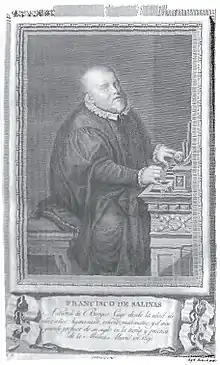Francisco de Salinas
Francisco de Salinas (1513, Burgos – 1590, Salamanca) was a Spanish music theorist and organist, noted as among the first to describe meantone temperament in mathematically precise terms, and one of the first (along with Guillaume Costeley) to describe, in effect, 19 equal temperament. In his De musica libri septem of 1577 he discusses 1/3-, 1/4- and 2/7-comma meantone tunings. Of 1/3-comma meantone, which is essentially identical to the meantone of 19-et, he remarks that it is "languid" but not "offensive to the ear", and he notes that a keyboard of 19 tones to the octave suffices to give a circulating version of meantone.

The 19th-century musicologist Alexander John Ellis maintained that Salinas really meant to characterize 1/6-comma meantone, and made a mistake due to his blindness. Others point out that Salinas's descriptions of his tuning as "languid" but not "offensive to the ear" seem to apply to 1/3-comma meantone, not to 1/6-comma meantone, which in any case has a much sharper fifth than musicians of Salinas's own time preferred.
Salinas was also interested in just intonation, and advocated a 5-limit just intonation scale of 24 notes he called instrumentum perfectum.
Blind from the age of eleven, Salinas served as organist to the celebrated Duke of Alba, and afterwards (starting in 1567) as professor of music at the University of Salamanca. His own compositions for organ have been lost. The poet Fray Luis de Leon admired Salinas greatly, knew him personally, and wrote an ode in homage to the musician.
References
- Salinas, Francisco de, De musica libri septem, Mathias Gastius, Salamanca, 1577, 1592. Reprint M.S. Kastner (ed.), Documenta Musicologica I no. 13 (Kassel: Bärenreiter, 1958).
- León Tello, Francisco José. "Francisco de Salinas" Estudios de historia de teoría musical (Madrid: IEM, CSIC, 1962), pp. 539-642.
- García Matos, Manuel, “Pervivencia en la tradición actual de canciones populares recogidas en el siglo XVI por Salinas en su tratado De musica libri septem,” Anuario Musical, XVIII (Barcelona, 1963), 67-84.
- "Salinas", in New Grove Dictionary of Music and Musicians, (London: Macmillan, 1980).
- Fernández de la Cuesta, Ismael, (transl.) Siete Libros sobre la Música. Primera versión castellana (Madrid: Editorial Alpuerto, 1983).
- Garcia Fraile, Dámaso. “Salinas, catedrático de la Universidad de Salamanca,” in Livro de homenagem a Macario Santiago Kastner (Lisbon: Fund. Calouste Gulbenkian, 1992), pp. 431-62.
- Otaola González, Paloma, “Francisco Salinas y la teoría modal en el siglo XVI,” Nassare, XI (1995), 367-85.
- Alin, José Maria, "Francisco Salinas y la canción popular del siglo XVI," in P.M.PiNnero Ramírez, (coord.) Lírica popular, lírica tradicional: lecciones en homenaje a Don Emilio García Gómez (Seville: Univ. de Sevilla, 1998), I, págs. 137-58.
- Otoala González, Paloma, “Las fuentes en el De musica libri septem de Francisco Salinas,” in M. de C. Gómez and M. Bernado (eds.), Fuentes musicales en la Peninsula Ibérica (ca. 1250-ca. 1550). Fonts musicals a la Peninsula Ibérica (Lerida: Inst. d’Estudis Ilerdencs, Univ. de Lerida, 2001), pp. 359-83.
- Katz. Israel J. "Francisco de Salinas and 'Conde Claros fraile', in Judeo-Spanish Ballads from Oral Tradition. Carolingian Ballads (2): Conde Claros (Newark, DE: Juan de la Cuesta, 2008), pp. 293-379.
- Rubio de la Iglesia, Fernando, "Las melodías populares en 'De Música libri septem' de Francisco de Salinas: Estudio comparado de algunos ejemplos," in A.S. García Pérez and P. Otaola González (coords.) Francisco de Salinas: Música, teoría y matemática en el Renacimiento (Salamanca: Univ. de Salamanca, 2014), pp. 219-53.